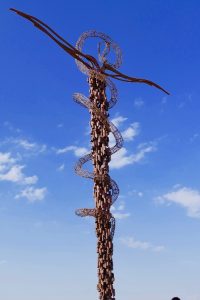HOMILY LENT WEEK 05 02 – Year II
Spiritual Vaccination:
Optional Memorial of St. Vincent Ferrer
(Num 21:4-9; Ps 102; Jn 8:21-30)
*********************************
Have you ever wondered why we Catholics put so much emphasis on the crucifix, bearing a corpus, and not just a plain cross? One example would certainly be my own Oblate cross and pectoral cross.
The readings today invite us to put our faith in the crucified Christ, hanging on the cross between two thieves.
Richard Rohr has some very interesting insights into today’s readings in a Lenten reflection he entitled Spiritual Vaccination. I would like to share them along with some of my own reflections.
 The focus is on the rod of Asclepius, or it’s common variation, the caduceus, on medical insignia throughout the world. It was the symbol of the Greek god of healing, and is found in the first reading from the book of Numbers (21:4-9). It is a single or double serpent winding around a pole. We are not sure if the Greeks or the Hebrews had it first. But its meaning was a universal discovery that today we would call “vaccination.” In short, “the cause is also the cure.” This seems to be true both medically and spiritually.
The focus is on the rod of Asclepius, or it’s common variation, the caduceus, on medical insignia throughout the world. It was the symbol of the Greek god of healing, and is found in the first reading from the book of Numbers (21:4-9). It is a single or double serpent winding around a pole. We are not sure if the Greeks or the Hebrews had it first. But its meaning was a universal discovery that today we would call “vaccination.” In short, “the cause is also the cure.” This seems to be true both medically and spiritually.
Moses prescribes such medicine to the complaining Hebrews in the desert, who were being bit by winged/fiery serpents. When the people complain to Moses, and Moses turns to God for a solution, God tells him to make a bronze version of the same and put it on a standard, which is unusual considering their prohibition against idols. The people were to look at this bronze serpent, and they would live. And it worked.
What I find significant is God actually tells Moses to “make a poisonous serpent.” Very interesting – a poisonous serpent that has no poison in it because it is made of bronze. That implies that the serpent on the standard looks exactly like the poisonous serpents on the ground – but heals instead of kills. What a powerful image of Jesus on the cross, who looked exactly like the two thieves, like a guilty criminal, yet was sinless and in that selfless action of giving his life for us, redeemed us and heals us to this day when we put our faith in him, the cause who is also the cure!
This meaningful and healing symbol returns again in John’s Gospel. The recurring phrase is “the one lifted up.” It has now become a rallying cry for Jesus who was raised up on the cross and thus “vaccinated us against” having the same being done to us (3:13 and 19:37). Jesus being “lifted up” is offered as a healing icon of love to all of history (12:32), and as a victory sign of the final resurrection and ascension of all humanity, as is prefigured in today’s account about the archetypal “Human One,” Jesus (8:28).
Rohr states this is powerful material, just as vaccinations are. The crucified Jesus is God’s vaccination plan against humanity’s desire to scapegoat and kill, reveals God’s universal and healing love, and helps us encounter God as the great healer.
This crucified one is divine medicine brought down to a small but potent dosage so we can handle it and it can handle us. That is what true spiritual symbols always do. Any direct contact with God is like contact with an electric wire – too powerful for us (recall that even Moses could not see the face of God). It will burn us unless we have some good filters (prayer, devotions, sacraments, other people) and a very humble humanity to receive it.
No wonder so many Catholics and Orthodox never tire of hanging images of the crucified Jesus in their homes and in their churches. We need to “lift up” and “gaze upon” the transformative image just as Moses first did in the desert. It can and did and will change many lives and much of history.
 Today, we honor St. Vincent Ferrer. A patron of builders, roofers and lumbers, Vincent was born in Spain in 1350. He joined the Dominicans in 1367, who sent him to study and teach philosophy throughout Europe. Despite his stern interpretation of the Christian message, Vincent became an amazingly successful preacher, converting thousands. He was also a key figure in ending the Western Schism, a divide in the Church over pretenders to the papacy. He died in 1419 and was canonized in 1455.
Today, we honor St. Vincent Ferrer. A patron of builders, roofers and lumbers, Vincent was born in Spain in 1350. He joined the Dominicans in 1367, who sent him to study and teach philosophy throughout Europe. Despite his stern interpretation of the Christian message, Vincent became an amazingly successful preacher, converting thousands. He was also a key figure in ending the Western Schism, a divide in the Church over pretenders to the papacy. He died in 1419 and was canonized in 1455.
As we ponder the Word of God today, and celebrate the Eucharist that makes present the unconditional love of Jesus on the Cross, let us pray for an always deeper faith in Christ crucified, and that we will continue to grow in the experience of the redemption wrought for us on the cross.



